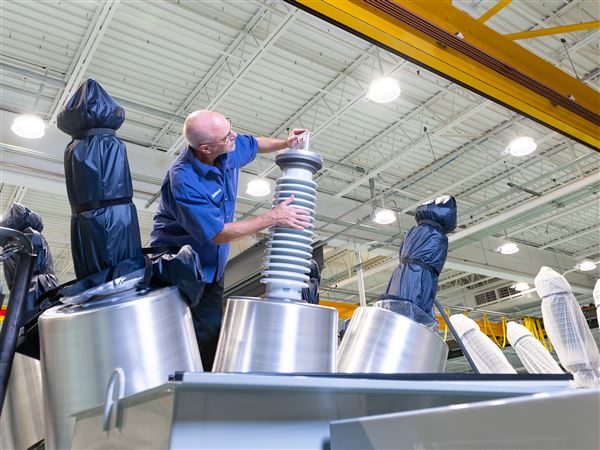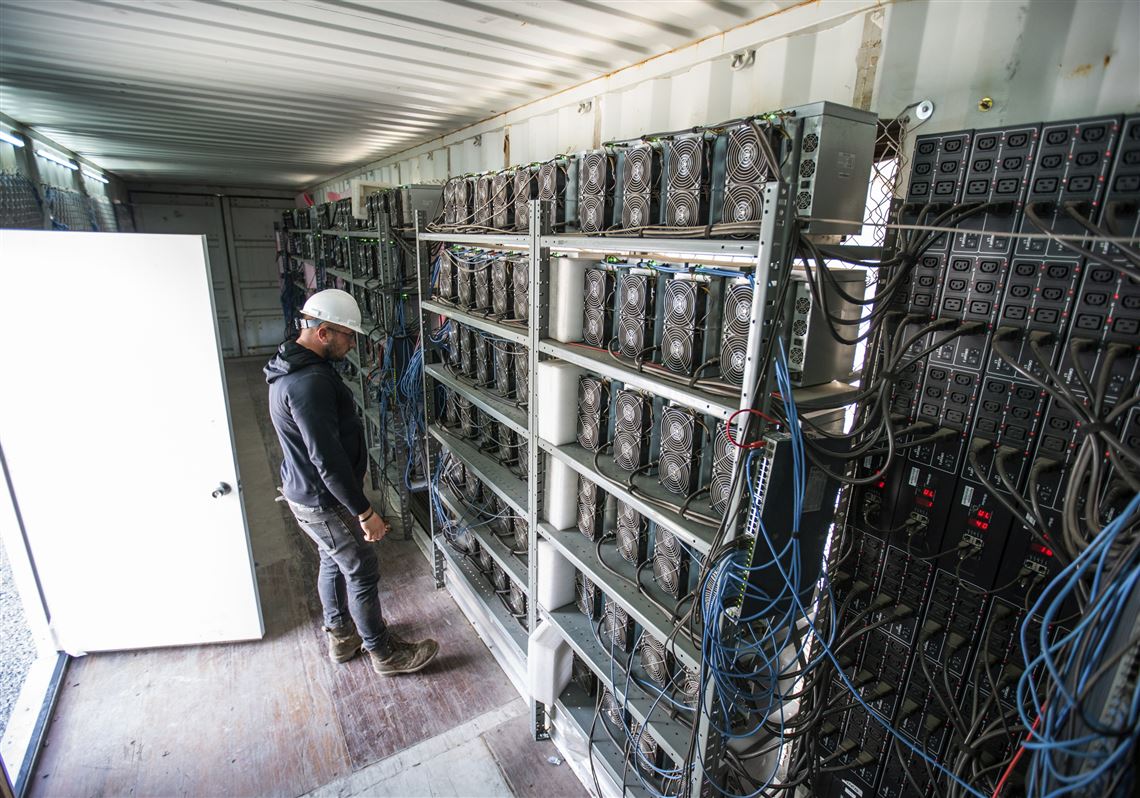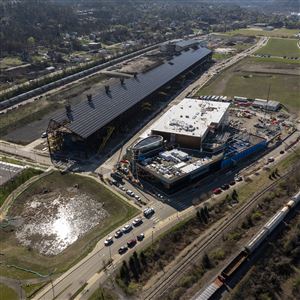A Canadian bitcoin mining company is taking up residence in Pennsylvania after formally purchasing two coal waste power plants in Venango and Carbon counties last week.
But what exactly does all that mean? What is bitcoin mining? And what is the company’s plan for the plants?
What is bitcoin?
Bitcoin is an entirely digital, decentralized currency, meaning there is no physical element to it and it doesn’t fall under the purview of a particular government or group of governments.
What is cryptocurrency?
Cryptocurrency is a broad term for any form of digital currency in which transactions are verified and records maintained by a decentralized system using cryptography, rather than by a centralized authority. Bitcoin is the first cryptocurrency variety ever released to the public.
Each cryptocurrency variety (of which there are many versions each only worth the value people are willing to assign to them) and each unit of value within each variety contains a copy of a distribution ledger that records all transactions across the history of the currency.
That’s referred to as a blockchain.
At the transaction level, cryptography (complex encoded messages that can be decoded by computer) is used to protect an individual’s personally owned bitcoin, validate transactions and add them to the globally connected ledger.
While some see bitcoin as a new investment frontier that isn’t tied to governmental outlooks, various countries such as China and Bolivia have banned the unregulated, open-source currency on fears of potential regulation skirting and use in illicit markets.
What is bitcoin mining?
The blockchain is kept up to date and in agreement through continuous power-intensive computations occurring across a global peer-to-peer network of computers specifically designed to handle the heavy load of solving the complex code that protects and unites bitcoin.
This is the “mining” process, which prevents “double-spending,” ensures that anyone who wishes to illegitimately alter the ledger would require more computing power than the rest of the network combined and regulates bitcoin issuance.
Vitally, it also issues new bitcoin.
For taking on the challenge via computational and power costs, “miners” are rewarded with a portion of bitcoin that’s released without paying any traditional currency.
As of Wednesday morning, bitcoin was priced at just over $89,000 a token.
Why is bitcoin mining a problem?
According to a study by United Nations University Institute for Water, Environment and Health and published in Earth’s Future journal, bitcoin mining consumed 173.42 terawatt hours of electricity in 2020 and 2021 — a number that would rank it 27th in the world as a country ahead of Pakistan and its population of 230 million.
Who invented bitcoin?
It was invented in 2008 by the secretive and elusive man referred to as Satoshi Nakamoto. He is said to have disappeared in 2010.
What is Bitfarms?
Bitfarms LLC is a Toronto-based global bitcoin mining company founded in 2017 and led by CEO Ben Gagnon.
Why has Bitfarms been interested in Pennsylvania?
The company’s interest in the Keystone state has largely been pinned on the presence of Stronghold Digital Mining Inc. and the power plants it owns until the transaction has closed.
Shareholders of Stronghold, a public company that owns the Scrubgrass waste coal power plant in Venango County and the Panther Creek waste coal plant in Carbon County, approved sale of their company to Bitfarms last week.
For investors, the state also provided a friendly operational climate.
“Pennsylvania is a conservative business friendly jurisdiction with a notably pro-Bitcoin & pro-energy Democratic Governor [Joshua Shapiro],” a Bitfarms investor presentation once highlighted.
Additionally, the presentation noted both plants are located near major metropolitan areas and “major fiber lines.”
What did Stronghold use the plants for?
Both plants utilize waste coal, left behind in gob piles from decades of mining, as fuel.
When Stronghold bought the plants six years ago, they were needed only at rare times of high demand — so it didn’t run all the time. Pairing it with bitcoin miners became a way to utilize the plant at full capacity and make the money on the crypto side of the equation when the energy side wasn’t paying.
If the grid called, the miners would be turned off and energy would shift to the grid, its owners said at the time.
But it might be the plants’ connection to the PJM Interconnection grid at those plants that brings the most value for Bitfarms. PJM coordinates the flow of electricity to 13 states, including Pennsylvania.
With an influx of data centers looking to hook into the grid (Bitfarms also acquired a data center site in Sharon, Mercer County, last year) along with increased manufacturing and electrification trends, PJM has warned that the system may be compromised in the coming years.
How much money was Stronghold making off the plants?
In 2022, Stronghold was making more money mining crypto than selling energy to the grid.
In 2023, that trend supercharged: just over $7.2 million came from its energy offerings, while $67.5 million came in from crypto mining and hosting.
During the first nine months of 2024, energy revenue fell below $1.5 million.
The company has struggled to turn a profit since it went public in 2021.
Why was Stronghold’s ownership tenure controversial?
The company was investigated by the Federal Energy Regulatory Commission for diverting power that it was supposed to offer into the grid toward its mining operations.
Federal regulators “determined that when prices were favorable, considering both PJM energy market prices and Bitcoin market prices, Scrubgrass directed the plant’s output towards its Bitcoin mining operations.”
It also imported electricity from the grid to its mining machines, at times misclassifying it as “station power”— electricity needed to run the power plant, which is sold at cheaper wholesale, rather than retail, rates.
In January, Stronghold agreed to a $1.4 million settlement with the federal energy regulator, with about half of it going to PJM as a disgorgement.
How much did Bitfarms pay for Stronghold?
Bitfarms will buy all Stronghold’s assets for $175 million in a transaction expected to close in March.
How will Bitfarms utilize the plants?
The company envisions building data centers on the campuses of the power plants, which it could isolate from the grid to ferry all their power to the computers onsite. The grid connections at each campus have “potential to double megawatts available for mining operations,” the company wrote.
While the Scrubgrass plant has a capacity of 85 megawatts and Panther Creek 80 megawatts, Bitfarms is projecting that by importing power from the grid it could eventually supply up to 955 megawatts for computing at the two sites.
Bitfarms plans to sign up its mining assets as a demand response resource, which means if the grid is short-supplied, it would pay Bitfarms to use less electricity.
“Participation in these programs is the first step in a broader energy arbitrage strategy that we will be developing in the coming months across our PJM portfolio,” Bitfarms’ senior vice president of global mining operations, Alex Brammer, said in a statement.
How widely has bitcoin been adopted?
Though 6 in 10 Americans say they have “little to no confidence that current ways to invest in, trade or use cryptocurrencies are reliable and safe,” according to Pew Research Center, Pittsburgh currently features nine bitcoin ATMs, and numerous businesses in America and around the world including have already begun accepting it. Such businesses include AMC Theaters, Home Depot and Pizza Hut to certain extents and in various locations.
Detroit is set to became the first city to accept cryptocurrency for tax payments in 2025, according to Cities Today.
And according to The Economic Times, Bank of America CEO Brian Moynihan, is of the mind the cryptocurrency will be utilized for major financial transactions “in the near future.”
First Published: March 5, 2025, 6:51 p.m.

















